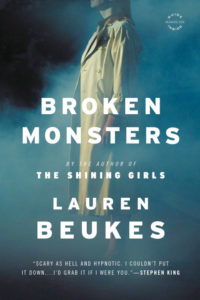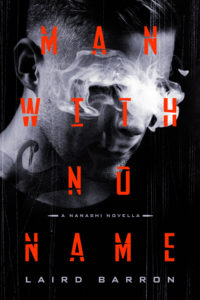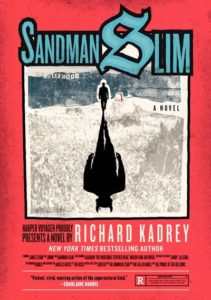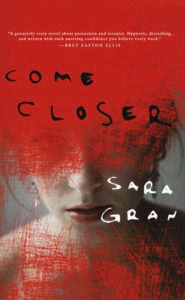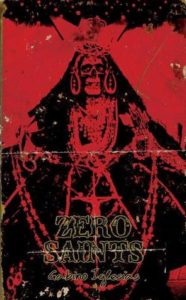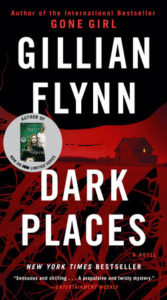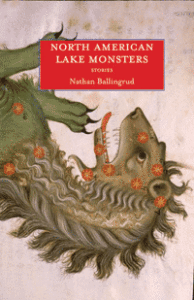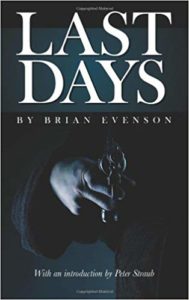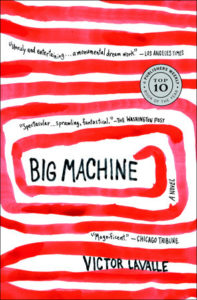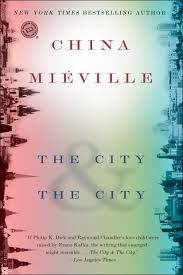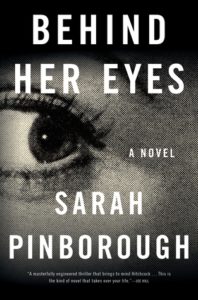I grew up on horror. The baby of the family, three older brothers, already teenagers, there’s no way they don’t shape your interests growing up. They loved horror; therefore, I loved horror. Never even had a chance. Five years old and begging my mom to turn on Evil Dead II again. Seven years old and faking the flu so I can watch Dead Alive just one more time before we gotta return the VHS to Hollywood Video. And when I wasn’t watching horror, I was reading it, starting with Goosebumps then the trashy Christopher Pike novels displayed next to the check-out stand at my local library and quickly progressing into Stephen King and Anne Rice and Richard Laymon. I lived and dreamed the genre.
Crime fiction didn’t really come my way until a little bit later. Around the time I was devouring horror, a few films would slip onto my radar, mostly whatever Quentin Tarantino was releasing along with all the Tarantino knockoffs who emerged in the late ’90s. It wasn’t until I turned twelve that I discovered my first real crime novel. Our family found ourselves in a bit of a crisis, shelter-wise. After school one day I sat in our old home, now sans electricity, waiting for my dad to pick me up after work and drive us to the motel we were living in at the time, and started rifling through all the old novels my parents had collected over the years. One of them, this thick, dusty paperback, caught my eyes immediately. In retrospect, I’m not sure why. The cover wasn’t anything special. The image was black and white, and portrayed a little boy’s hands gripping a chain-link fence. That’s it. I started reading and did nothing else for the rest of the night, then skipped school the next day and continued it. The book? Richard Price’s Clockers. From there, it didn’t take long to uncover Elmore Leonard’s seemingly infinite treasure of crime fiction. I started with Rum Punch, since I loved Jackie Brown, and blew through everything else he’d ever written in the span of something like six months.
These two genres, horror and crime, have played a significant role in my life. They have practically shaped the person I am today. Without them, I am less whole. I’m someone else. Something alien. And the great thing about these two genres is, they so often tend to blend beautifully together. When I think of crossover genres, horror and crime are perfect companions. They’re the peanut butter and jelly of genres. Sure, you can have one without the other, but goddamn do they blow your mind when you combine them. My second novel, The Mind is a Razorblade, would not have been written without a preexisting love for the horror/crime crossover. I’ve also published my own share of horror/crime titles through my small press, Perpetual Motion Machine. Titles like Jessica McHugh’s The Green Kangaroos, which invented a drug meant to be shot directly into one’s genitalia, and John C. Foster’s Dead Men and Night Roads, which involved four men being resurrected from the underworld to complete a hit-job on a little voodoo girl. Horror and crime are my religion, and I practice it regularly.
Here are twenty horror/crime crossover titles I highly recommend picking up for this spookiest of spooky seasons.

Thomas Harris, Red Dragon (1981)
Let’s start with a classic everybody undoubtedly already knows. Red Dragon is the novel that introduced Thomas Harris’s infamous character, Hannibal Lecter. Don’t try to be cool and act like you’ve never heard of him. You’ve heard of him. Fans of the notorious cannibal who retroactively visited Red Dragon hoping to snack on some tasty Lecter action might have found themselves disappointed, however, considering the dude’s really only present in one scene. Red Dragon is a very dark thriller about an ex-forensic investigator profiling a maniac butchering families, but it’s also deeply rooted in the horror genre. The aforementioned maniac isn’t your everyday killer. Instead there is a presence that’s attracted itself to a momma’s boy working in a film lab. Of course, the dude has many mental disorders, and the Red Dragon is almost definitely in his head, but it’s the way Thomas Harris portrays the Red Dragon’s voice that cements this one as a perfect horror/crime crossover. Certain scenes in this novel are guaranteed to make you sweat. You might also recognize this novel from Brett Ratner’s terrible film adaptation. Please erase this movie from your memory and instead replace it with the much more superior adaptation—Michael Mann’s Manhunter.
Lauren Beukes, Broken Monsters (2014)
By coincidence only did I read this novel during the initial airing of True Detective season one and, by golly, I can’t conceive of a more suitable companion to Nic Pizzolatto’s wonderfully fucked-up HBO series. The very first visuals Lauren Beukes offers her readers in Broken Monsters are of a dead little boy somehow attached to the lower half of a deer, officially becoming the lead protagonist’s weirdest crime scene she’s ever investigated. If Pizzolatto ever runs out of juice, it would only make sense to adapt Broken Monsters in a future season of True Detective. It has that TD vibe written all over it.
Laird Barron, Man with No Name (2016)
It’s no secret that we’re big fans of Laird Barron here at CrimeReads. The man is one of the leading champions of cosmic horror and, with the release of his new novel, Blood Standard, he’s very quickly shooting up as a rising contender for great crime novelist. Blood Standard has its share of horror elements, particularly in one grisly Alaska scene early on in the book, but the most obvious example of Barron mixing both crime and horror is a novella released only a couple of years ago. In Man with No Name, an enforcer for a Yakuza crime family gets stuck with the task of abducting a pro wrestler. Simple enough plot, right? Maybe you’ve forgotten which author we’re dealing with here. There is nothing simple about Man with No Name. There is only the nightmarish horrific atmosphere of a tale spun with expert craftsmanship. It blends noir and cosmic horror effortlessly.
Richard Kadrey, Sandman Slim (2009)
It’s difficult to discuss crime/horror hybrids without acknowledging Richard Kadrey’s Sandman Slim series. The tenth book just hit bookstores this August, and for good reason. People love this character and will happily follow him to Hell and back, and back and back and back. In the first novel, the titular Sandman Slim escapes from literal Hell to take revenge on those responsible for his lover’s death. In later books, he starts up somewhat of a bounty hunter business tracking down monsters for money. In the wise words of that depressed bird from The Flintstones: “It’s a living…”

William Hjortsberg, Falling Angel (1978)
Falling Angel is a classic, through and through. A private detective is hired to track down a missing ex-jazz musician, only to uncover something far more sinister. We’re talking cults, voodoo, satanists, the works. Everything you could possibly want, all in one book. You’ve probably seen the 1987 film adaptation, starring Mickey Rourke and Robert DeNiro, which was retitled Angel Heart for reasons that remain a mystery to me.
Sara Gran, Come Closer (2003)
Sara Gran is an author I’ve only recently discovered and, after devouring Come Closer in a single sitting, I can confidently admit I cannot wait to go through the rest of her bibliography. The narration in Come Closer is about as twisted as they come. Imagine Patrick Bateman from American Psycho, only minus the natural pretentiousness that infects any of Bret Easton Ellis‘s writing. I’m a sucker for a good demon possession story, and Gran practically steals the crown here. Her protagonist is sick, and with this sickness comes a desire to commit some severely terrible crimes, from petty shoplifting to m-m-m-m-murder! I was grinning ear-to-ear the entire time.
Andy Davidson, In the Valley of the Sun (2017)
The vampire genre has a bad rap these days, and I get it, it’s easy to try cashing in on their popularity. It’s easy to get lazy. Thankfully, Andy Davidson gave his debut novel everything he had in him, and readers were gifted something truly amazing. Part ’Salem’s Lot, part Red Dragon, part Henry: Portrait of a Serial Killer, part No Country for Old Men, Davidson’s In the Valley of the Sun was easily my favorite novel released in 2017. To break the plot down in its simplest of terms: a serial killer gets turned into a vampire and seeks employment at a small, rundown hotel somewhere in West Texas. What follows is pure bliss. This novel needs far more recognition than it has received.
Gabino Iglesias, Zero Saints (2015)
In an early endorsement for Zero Saints, Jerry Stahl (author of Permanent Midnight) called Gabino Iglesias the “Barrio Palahniuk,” and honestly it’s tough to come up with a better description. In Zero Saints we have terrifying gangsters feeding people to even more terrifying creatures to resolve territorial disputes. Decapitations, priestesses, hitmen, and so much more await you. Also, don’t miss Iglesias’s next novel, Coyote Songs, coming out on Halloween. I’m positive it’ll be just as good, if not better, than Zero Saints.
Gillian Flynn, Dark Places (2009)
Gillian Flynn has only released three novels since her career as a novelist began in 2006, and each title has been a gift straight from the gods of crime fiction. While all three books get very dark, it’s her sophomore title, Dark Places, that most straddles the boundaries of horror. A woman in her early thirties takes advantage of a secret society obsessed with famous murders. When she was a small child, her older brother slaughtered their mother and two sisters, and it was her testimony that imprisoned him for life. Now, twenty-six years later, she’s revisiting her childhood trauma for a quick buck. She learns the past is sometimes more fluid than solid, and things have a way of appearing differently under new light. As the title hints, this book gets quite dark.
Nathan Ballingrud, North American Lake Monsters (2013)
One of the best single-author horror collections I’ve ever read is hands-down North American Lake Monsters. Nathan Ballingrud is an author I’ll drop everything for if I learn he has something new out. His stories tend to focus on relatable human issues—relationships spiraling out of control, parents struggling not to disappoint their children, people doing whatever it takes to get the rent paid. Take out the horror elements from most of his fiction, and often times they still work, albeit a little less complete feeling. Ballingrud has found the perfect balance of neo-noir and horror with his fiction. In his collection, North American Lake Monsters, he gives us stories about children holding vampires hostage under their crawlspace, skinheads trying to find their place in the world, and so much more. Don’t enter this book hoping for clean resolutions. Ballingrud isn’t interested in tying everything together in a gift box for his readers. Some of these stories will leave you empty inside, like he took out a blade and scraped you hollow.
Brian Evenson, Last Days (2009)
Brian Evenson can do no wrong. Few authors can genuinely creep me out the way he can. He has the ability to distort the very rules of language, of twisting his reader’s perception of reality. Last Days is probably my favorite of all his work, which involves a man being kidnapped by a cult that worships mutilation. They want him to solve a case: who has murdered their leader? The more significant role in the cult you play, the more body parts you’re missing. If you want to speak to some of these people, you better have dismembered an equal portion of limbs. And if the protagonist wants to escape this cult’s island alive, he’s gonna have to speak to some of these higher-ups, which means once again turning a blade onto himself.
Karin Slaughter, Pretty Girls (2015)
It’s hard to get darker than the world of snuff films, and in Karin Slaughter’s Pretty Girls we visit it aplenty. This is no easy read. You will find certain sections uncomfortable, as all good horror should make you feel from time to time. Two sisters team up and investigate the disappearance of a little girl and the murder of a man. Are the cases connected? Almost certainly. Do not go into this book with your guard down. It will tear you to shreds.
Nate Southard, Bad Dogs (2018)
At a recent convention, Nate Southard described his latest novel from Broken River Books as a hillbilly magician fighting demons. I practically threw my wallet at his face the moment these words left his mouth. Bad Dogs does not disappoint. Imagine everything great about David Wong’s John Dies at the End, only from the perspective of an author with deep roots in crime fiction. In this book expect to encounter the Dixie Mafia, zombie dogs, cursed grimoires, demonic shapeshifters, and lots and lots of meth.
Mary SanGiovanni, Chills (2016)
Described as “True Detective meets H.P. Lovecraft” it won’t take readers long to realize why Mary SanGiovanni’s Chills has been included in this article. Typically, murder investigations are a pain in the ass, and that’s never been truer than during insane snowstorms, especially when all signs point to the crime being part of some kinda screwed-up ritual slaying. And of course the kill-count doesn’t stop with just one. Snow falls, people drop. It’s a good fun time for the folks living in Colby, Connecticut.
Victor LaValle, Big Machine (2009)
In Big Machine, the survivor of a suicide cult joins up with a team of paranormal investigators comprised of former addicts and petty criminals. Each member is connected by the fact that, at one point in each of their lives, they’ve claimed to have heard the voice of God. I’m a sucker for anything involving weird religious cults, so it was unlikely I’d ever not love this book. Plus, it’s hard to go wrong with a novel that opens with a quote from John Carpenter’s The Thing.
China Mieville, The City & the City (2009)
Many fans of Mieville might disagree with the placement of The City & the City on this list. Mieville isn’t often considered a horror writer, as the majority of his fan base belongs to fantasy devotees. It’s impossible to classify Mieville as just one thing. His 2009 novel, The City & the City, easily falls under crime fiction, yes, and of course fantasy, but I’d argue also horror. The basic set-up: a student is found dead in an alley, and investigators must look for clues inside two different cities occupying the same space simultaneously. This book is very weird, sometimes funny, but almost always dripping with dread. It’s a police procedure for those bored with police procedures.
Kelli Owen, Floaters (2016)
I’m a strong advocate that there are never enough lake monster stories in the horror genre. Have you ever stared at a lake in the middle of the night? Anything can be hiding inside. You don’t know. Kelli Owen takes this concept and runs with it in Floaters. Sometimes corpses wash up from Lake Superior, but also sometimes the terrifying creature responsible for the corpses washes up, too. A detective, medical examiner, and reporter team up to hunt down a beast that should not exist. I recommend this one for fans of lake monsters and small-town legends. It’s a fun ride.
Sarah Pinborough, Behind Her Eyes (2017)
What starts off as a standard thriller quickly evolves into something much, much weirder. Sarah Pinborough isn’t afraid to stray from the norm, and that’s never been clearer than in 2017’s Behind Her Eyes. When people discuss this novel, they tend to bring up the ending. I won’t say much about it here, except that you have no idea where it’s going, even if you think you do. To say anything more would only be spoiling it. Trust me: just when you think this thing is going one way, it cuts a sharp right the opposite direction. There’s a reason I’m including it in a list of horror/crime crossovers.
Tana French, In the Woods (2007)
Tana French is becoming one of my favorite writers. I haven’t made it through every title found in her ever-growing bibliography, but those I’ve read have blown my mind. Every novel aside from her latest are part of a series of standalone titles labeled the Dublin Murder Squad Series. You do not need to read them in any specific order, as the narrator tends to change every time. Sometimes characters from other novels make appearances, but you aren’t missing too much by flipping through the series randomly. However, for my Tana French entry in this article I will go ahead and recommend her debut novel, In the Woods. Her novels can and should be classified as thrillers, but they’re very, very dark thrillers. Often, horror is defined by a story’s atmosphere, and in French’s writing the atmosphere rivals any other champion of the genre. There is always a hint of something…deeper going on in her books. The best way I can describe it is to bring up the first season of True Detective again. Nothing supernatural ever actually occurs, but if it did, you wouldn’t entirely be surprised, right? In fact, you’d almost be relieved. That’s the feeling one gets while reading Tana French. We’re dipping our toes in the possibility of something cosmic happening, but we’re never actually taking the full dive. Reading Tana French is like welcoming anxiety directly into your body. Prepare to be stressed the hell out.
Ellen Datlow, Supernatural Noir (2011)
I can think of no better way to end this article then by recommending Ellen Datlow’s 2011 anthology, Supernatural Noir. Rather than do a breakdown of plots, I will just list the contributors, and you tell me if you aren’t instantly drooling from the mouth: Gregory Frost, Paul Tremblay, Melanie Tem, Caitlin R. Kiernan, Brian Evenson, Lucius Shepard, Laird Barron, Nick Mamatas, Lee Thomas, Jeffrey Ford, Richard Bowes, Elizabeth Bear, Nate Southard, John Langan, Tom Piccirilli, and Joe R. Lansdale. Holy shit. What are you waiting for?


